Disciplinary Meeting Minutes Samples
-
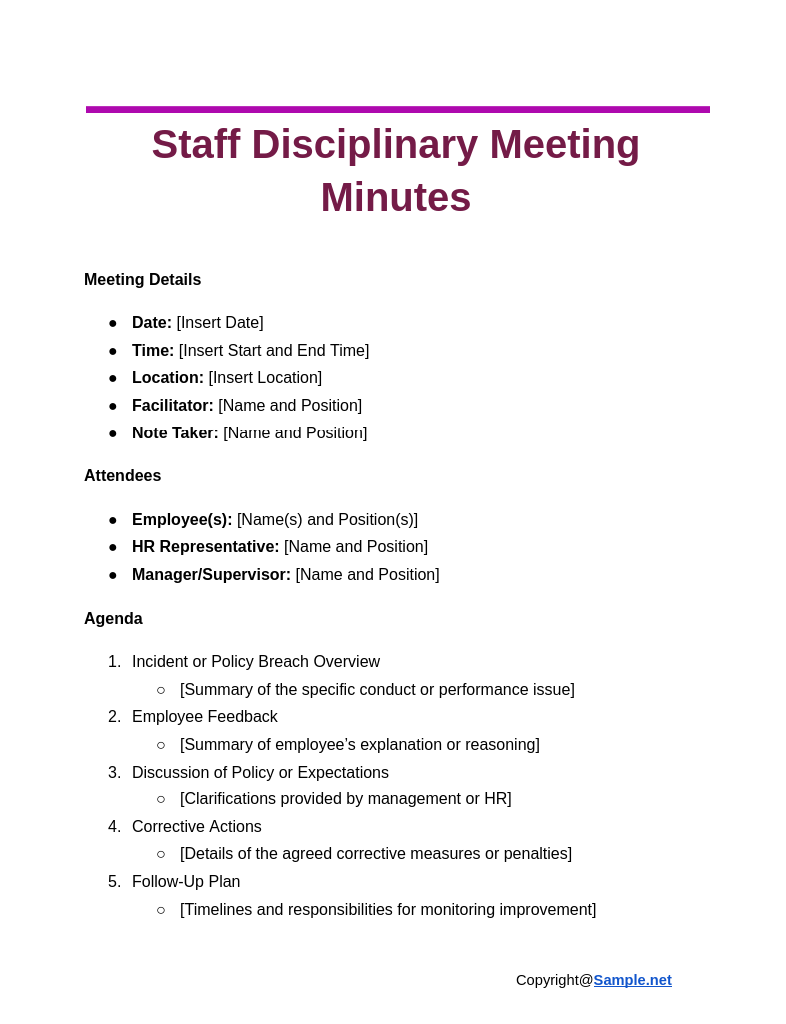
Staff Disciplinary Meeting Minutes
download now -
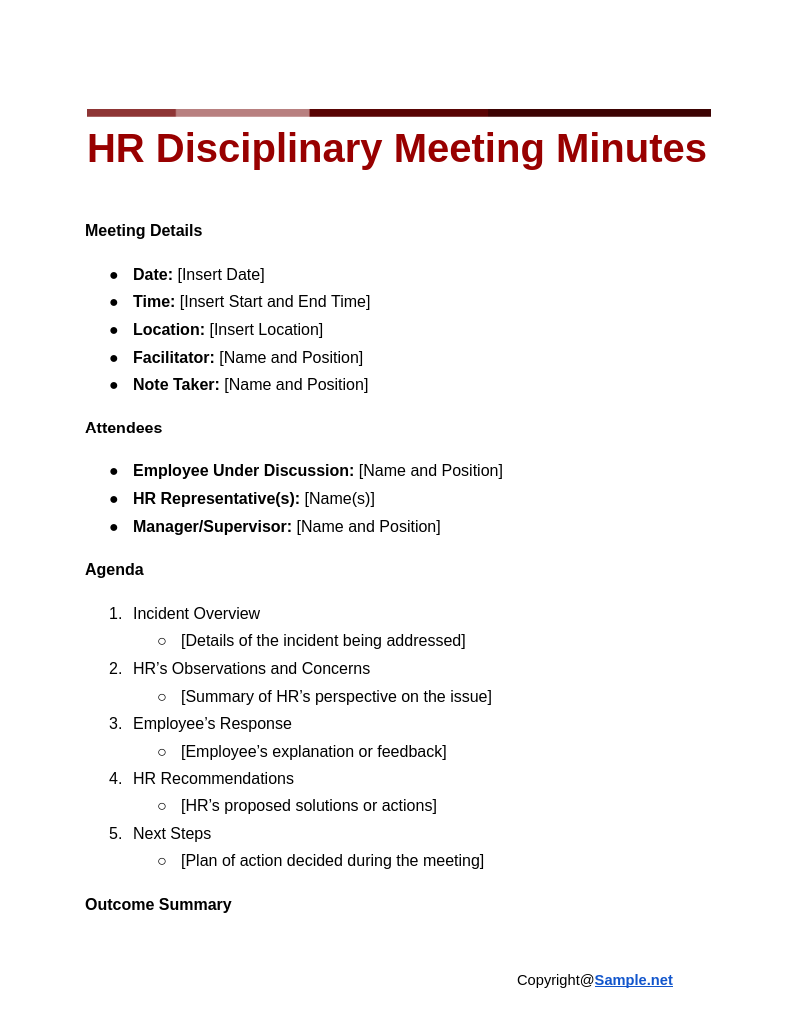
HR Disciplinary Meeting Minutes
download now -
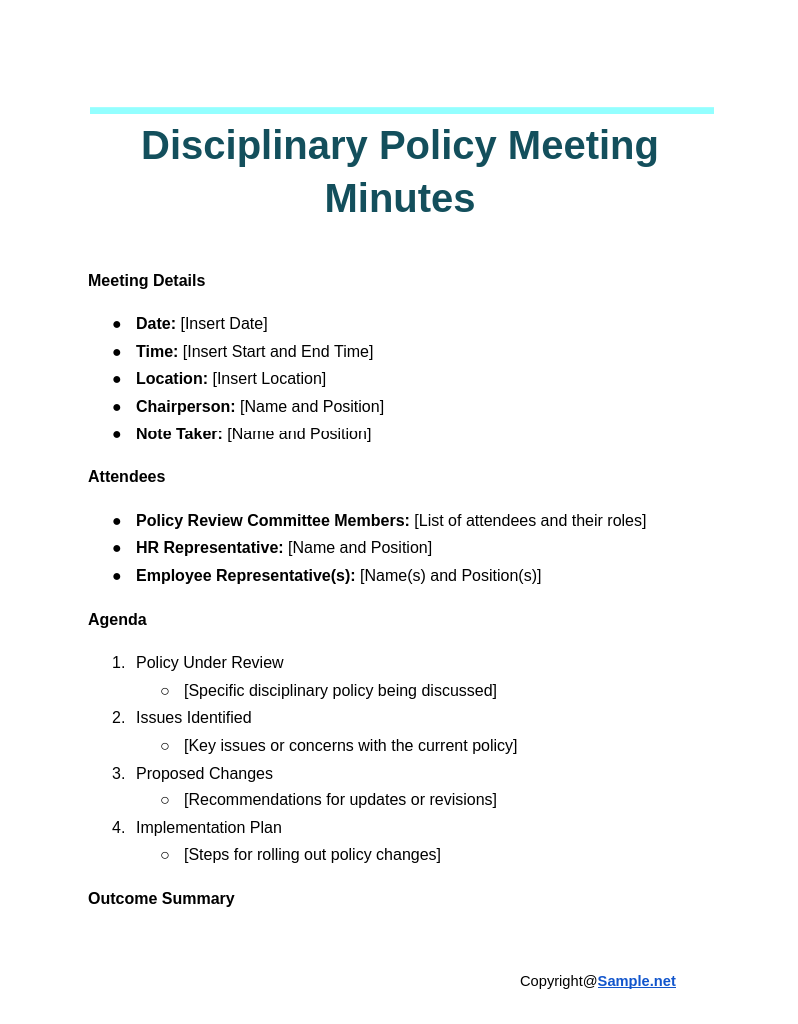
Disciplinary Policy Meeting Minutes
download now -
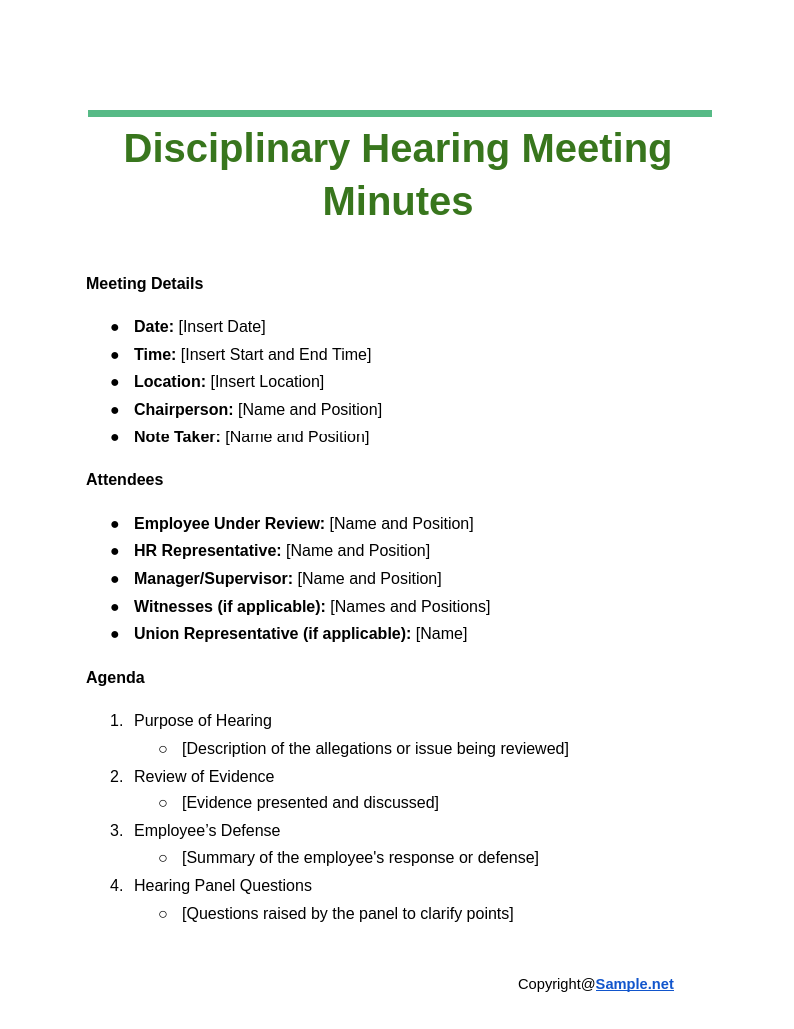
Disciplinary Hearing Meeting Minutes
download now -
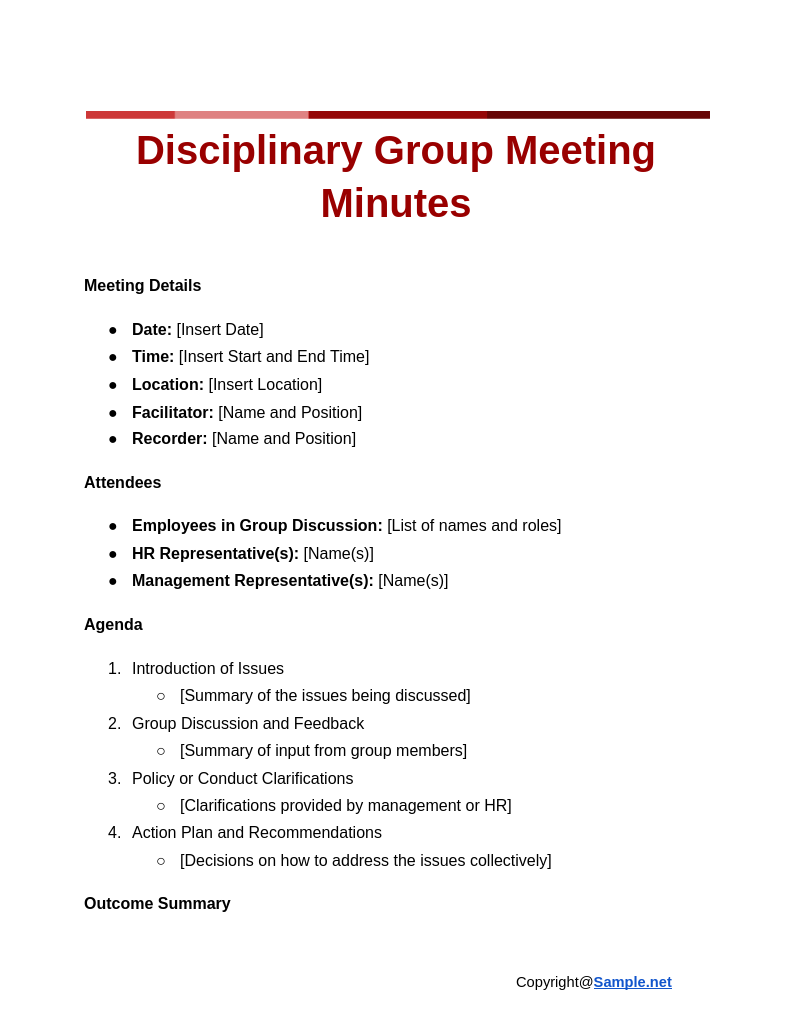
Disciplinary Group Meeting Minutes
download now -
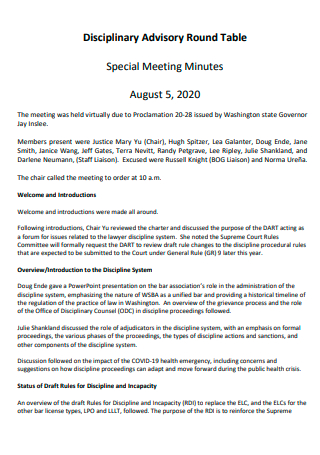
Disciplinary Advisory Round Table Special Meeting Minutes
download now -

Student Disciplinary Committee Meeting Minutes
download now -
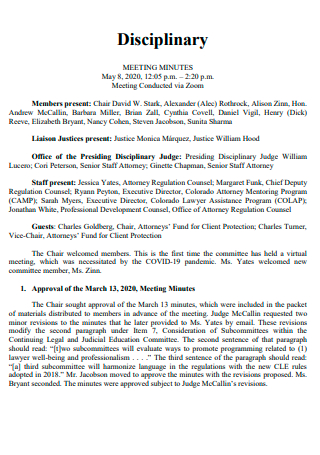
Disciplinary Meeting Minutes Example
download now -
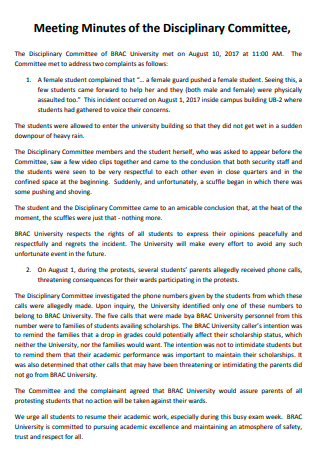
Disciplinary Committee Meeting Minutes
download now
FREE Disciplinary Meeting Minutes s to Download
Disciplinary Meeting Minutes Format
Disciplinary Meeting Minutes Samples
a Disciplinary Meeting Minutes?
Purposes of Disciplinary Meeting Minutes
How to Create Disciplinary Meeting Minutes
FAQs
Why is discipline necessary?
What purpose does a disciplinary interview serve?
Is discipline a good thing?
What details should disciplinary meeting minutes include?
What happens if disciplinary meeting minutes are inaccurate?
What is the role of witnesses in disciplinary meeting minutes?
How should sensitive information in disciplinary minutes be handled?
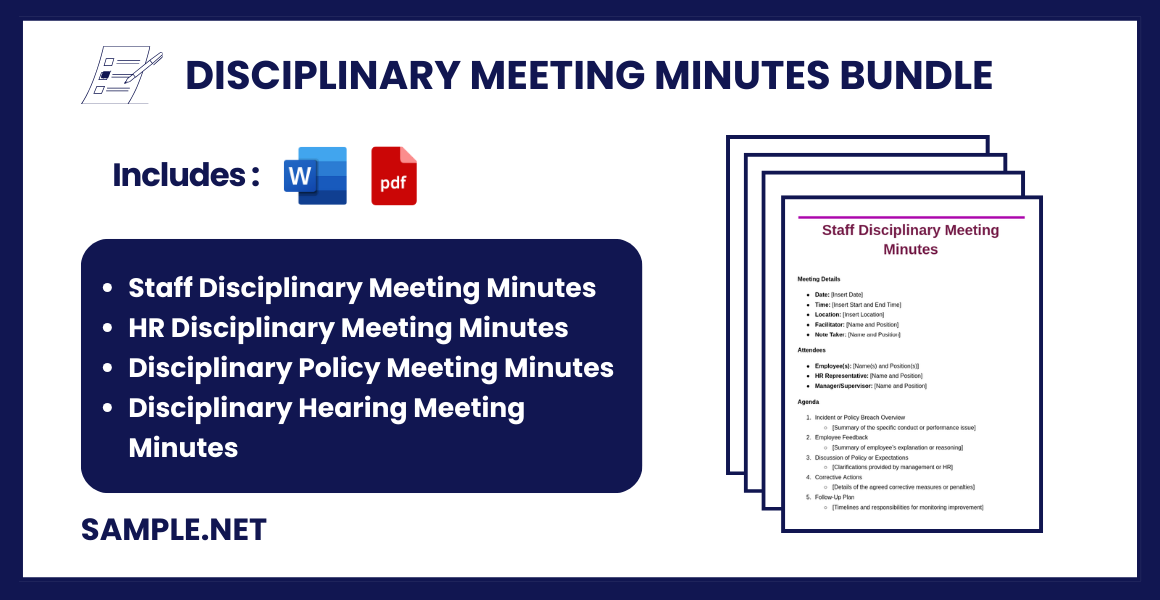
Download Disciplinary Meeting Minutes Bundle
Disciplinary Meeting Minutes Format
Meeting Details
- Date: [Insert Date]
- Time: [Insert Start and End Time]
- Location: [Insert Location]
- Chairperson: [Name and Position]
- Note Taker: [Name and Position]
Attendees
- Employee Under Review: [Name and Position]
- HR Representative: [Name and Position]
- Manager/Supervisor: [Name and Position]
- Witnesses (if applicable): [Names and Positions]
- Union Representative (if applicable): [Name]
Agenda
- Purpose of the Meeting:
- [Brief description of the reason for the meeting, such as “To address allegations of misconduct related to …”]
- Review of Incident Details:
- [Overview of the incident or issue under review]
- Employee’s Response:
- [Details of the employee’s explanation or defense]
- Discussion and Questions:
- [Summarize any questions or clarifications discussed]
- Outcome or Decision:
- [Action steps or resolutions decided, such as issuing a warning, termination, or further investigation]
Key Points Discussed
Incident Overview: [Detailed account of the incident, including dates, times, and key details]
Evidence Presented: [List evidence discussed during the meeting, such as documents, recordings, or witness statements]
Employee’s Explanation: [Summarize the employee’s statements or defense]
Questions Raised by the Panel: [Any questions or clarifications asked by the meeting attendees]
Conclusion
- Outcome of the Meeting:
- [State the decision clearly, such as “Final warning issued” or “Further investigation required.”]
- Next Steps:
- [Details on any follow-up actions, deadlines, or additional meetings]
Signatures
- Chairperson: ___________________________ Date: __________
- Employee: ___________________________ Date: __________
- Witness (if applicable): ___________________________ Date: __________
- Union Representative (if applicable): ___________________________ Date: __________
Additional Notes
- [Include any additional comments, questions, or observations relevant to the meeting]
What is a Disciplinary Meeting Minutes?
Disciplinary meeting minutes are detailed records created during meetings focused on addressing employee behavior or performance concerns. They capture critical aspects like the attendees, agenda, discussions, decisions, and any follow-up actions. These minutes are typically created to document compliance with workplace policies, provide clarity, and ensure fairness in handling disciplinary matters. They are essential for both employees and employers to maintain transparency in resolving workplace issues. You can also see more on Office Meeting Minutes.
Purposes of Disciplinary Meeting Minutes

1. Documentation of Proceedings
Disciplinary meeting minutes serve as an official record of the meeting, capturing the discussions, evidence presented, and decisions made. This documentation ensures transparency and provides a reference for any future actions or reviews.
2. Ensuring Transparency
Minutes ensure that all parties involved—employees, management, and HR—have a clear understanding of the meeting’s content. This transparency fosters trust and demonstrates fairness in addressing workplace issues. You can also see more on Monthly Meeting Minutes.
3. Compliance with Policies
Maintaining disciplinary meeting minutes helps organizations adhere to internal policies and external legal requirements. Proper documentation proves compliance and mitigates risks of procedural errors.
4. Protection Against Disputes
In case of disputes, grievances, or legal actions, disciplinary meeting minutes serve as evidence to validate the actions taken and the fairness of the process followed. You can also see more on Training Meeting Minutes.
5. Guidance for Follow-Up Actions
Minutes outline any agreed-upon steps, timelines, or measures for improvement. They provide a structured framework for follow-up, ensuring accountability and progress monitoring for all involved parties.
How to Create Disciplinary Meeting Minutes
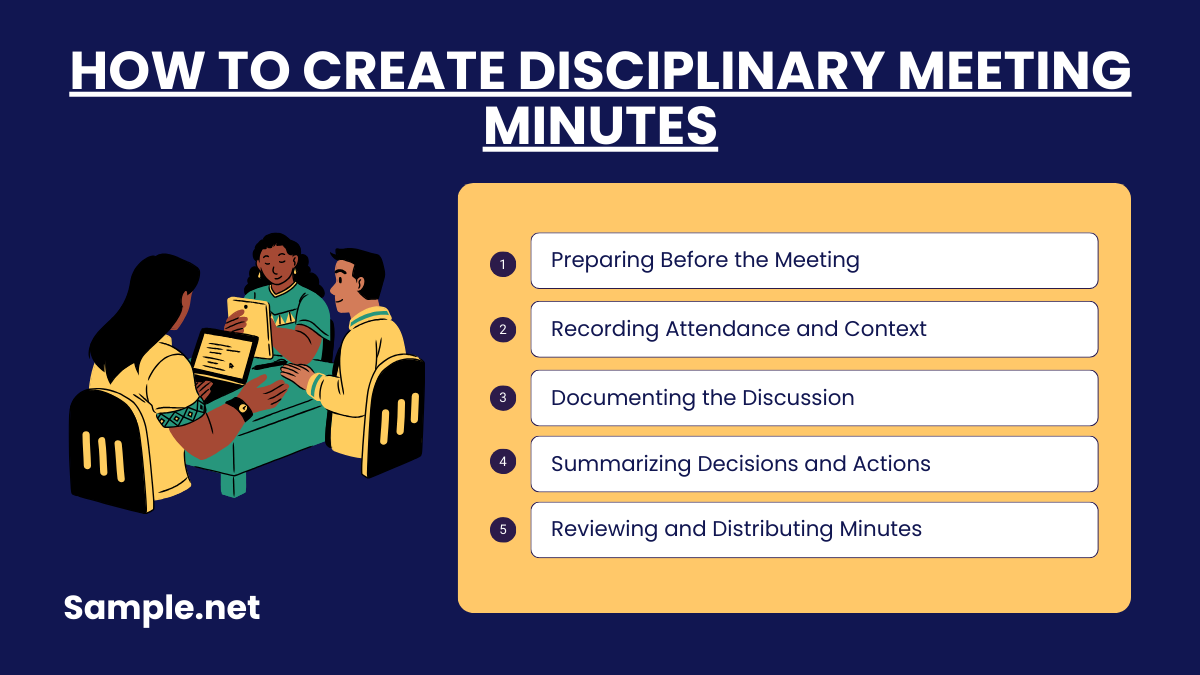
Step 1: Preparing Before the Meeting
Start by gathering all necessary information, including the meeting agenda, names of attendees, and relevant policies or documents. Familiarize yourself with the employee’s case and any prior records to ensure accuracy. Clearly define the purpose of the meeting and set a professional tone to ensure all parties feel respected and heard. You can also see more on Staff Meeting Minutes.
Step 2: Recording Attendance and Context
At the beginning of the meeting, note the names and roles of all attendees, including the employee, management representatives, and any witnesses. Briefly state the purpose of the meeting, highlighting the specific issues being addressed. Ensure the start and end times of the meeting are recorded accurately.
Step 3: Documenting the Discussion
During the meeting, focus on capturing key points rather than verbatim statements. Record the employee’s response to allegations or concerns, management’s feedback, and any suggestions or proposed actions. Include relevant details about evidence presented or policies discussed, ensuring the minutes remain unbiased and factual.
Step 4: Summarizing Decisions and Actions
Summarize the conclusions reached, including any disciplinary actions such as warnings, suspension, or termination. Document any agreements on follow-up actions, timelines, or additional support provided to the employee. Specify responsibilities for implementing these decisions to avoid ambiguity. You can also see more on Weekly Meeting Minutes.
Step 5: Reviewing and Distributing Minutes
After the meeting, review the minutes for accuracy and completeness. Ensure they are free from errors and reflect the discussion impartially. Distribute the finalized minutes to all relevant parties, including the employee and management, ensuring confidentiality and compliance with organizational policies.
Disciplinary meeting minutes play a vital role in maintaining workplace integrity and fairness. They provide a transparent account of discussions and decisions, ensuring all parties are informed and actions are documented. Properly drafted minutes foster a culture of accountability and professionalism, protecting both employees and employers in disciplinary matters. By following a structured approach, organizations can handle such meetings effectively and with due diligence. You can also see more on Management Meeting Minutes.
FAQs
Why is discipline necessary?
Discipline equips individuals with guidelines for living a more efficient and practical life. When you maintain a sense of discipline in your life, you may make little sacrifices in the present in trade for a brighter future. Discipline develops habits, habits develop routines, and routines develop into who you are daily.
What purpose does a disciplinary interview serve?
A disciplinary interview gives both the employee and the manager a chance to have a whole and open conversation about the matter at hand. The interview lets the employee tell their side of the story and give an answer. You can also see more on Community Meeting Minutes.
Is discipline a good thing?
Self-discipline permits you to pick and then persist in actions, ideas, and behaviors that contribute to your progress and success. Additionally, it provides you with the power and inner strength necessary to overcome addictions, procrastination, and laziness and complete whatever task you undertake.
What details should disciplinary meeting minutes include?
Minutes should include the meeting’s date, time, attendees, agenda, discussion points, decisions, and any follow-up actions agreed upon. You can also see more on Group Meeting Minutes.
What happens if disciplinary meeting minutes are inaccurate?
Inaccurate minutes can lead to misunderstandings, disputes, and legal challenges. Reviewing and confirming the minutes with all parties minimizes such risks and ensures accuracy.
What is the role of witnesses in disciplinary meeting minutes?
Witnesses provide additional accounts of the discussion and verify the accuracy of events documented, reinforcing the credibility of the minutes.
How should sensitive information in disciplinary minutes be handled?
Sensitive details must be recorded accurately but shared only with authorized personnel. Organizations should follow confidentiality policies and data protection laws. You can also see more on Team Meeting Minutes.
